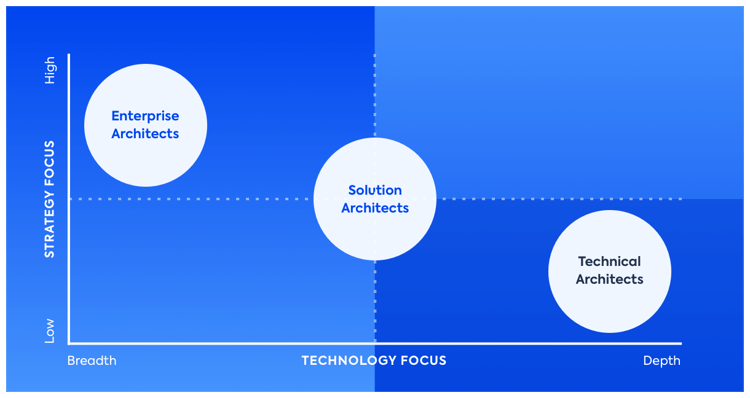What are the must-haves for a successful technical architect?
To be a successful TA, candidates must be highly skilled in the structure of IT systems, manage teams, and deliver solutions. The main TA's values include:
- A Bachelor’s or post-graduate degree in IT, computer science, computer engineering, or equivalent.
- Strong and up-to-date knowledge of software applications, programming languages, and hardware.
- Ability to prioritize, delegate, meet deadlines and work under pressure.
- Ability to mitigate risk, troubleshoot issues, and find solutions.
- Strong interpersonal and communication skills to understand and explain concepts to both managerial and technical colleagues.
- Several years of hands-on experience in project managing and IT.
- Certificates to demonstrate ability and competency.
Comparison to other roles
Technical architect vs. software engineer
While tech architects will be involved with software engineering, their role is more focused on planning and designing systems. Software engineers, on the other hand, will usually be responsible for implementing those plans in the desired language.
Having said this, the roles and responsibilities of both positions will occasionally overlap. Technical architects are required to have in-depth knowledge of IT systems and to lead a team of software developers.
Technical architect vs. the principal architect
Technical architecture is a highly specialized role focused on IT systems, infrastructure, and networking. A principal architect, however, will have a broader set of responsibilities.
Their focus may be on business domains, a large implementation project, or the entire enterprise. It’s also a title used to signal a level of (experience) superiority over other architects in the team.
Technical architect vs. application architect
Application architecture is invested in the building blocks of application design. They design models and flow charts that track the behavior of applications used throughout a business. They focus on the relationships between them; e.g. how they interact with each other and with users.
Tech architects are concerned with designing, updating, or implementing IT systems within an enterprise, with the goal of improving its value and executing solutions. Both application architects and TAs may work together on projects which require application oversight.

Technical architect vs. software architect
While both roles are similar in nature, software architects work with software components such as programming languages, IDEs, libraries, APIs, etc. – the fundamental structures of a software system.
Tech architects are responsible for leading IT teams to ensure technology developed is aligned with the functional and non-functional requirements of the business. They design and map out strategies, and guide other IT experts and specialists on the right course of action to achieve the desired outcome.
Technical architect vs. technical manager
Both tech architects and technical managers are in charge of overseeing the development, implementation, and maintenance of IT systems and processes. However, they are each responsible for different aspects of the project.
Tech architects will be focused on the system design and establish the most appropriate and sustainable technology solution for the business need. Technical managers, on the other hand, will take on responsibility for the operational aspects, e.g. budget, staffing, and delivery.
Conclusion
Technical architects are part of a wider network of interconnected IT architects who work closely together on individual aspects of large enterprise-wide projects.
They will work directly with enterprise architects, solutions architects, business architects, etc. to manage as-is state and transform them into future state architecture designed to improve day-to-day business processes.






/EN-WP-EA-Tomorrow-Resource_Page_Thumbnail.png?width=260&height=171&name=EN-WP-EA-Tomorrow-Resource_Page_Thumbnail.png)
/EN-TopStakeholderQuestions-Poster_Resource_Page_Thumbnail.png?width=260&height=171&name=EN-TopStakeholderQuestions-Poster_Resource_Page_Thumbnail.png)


